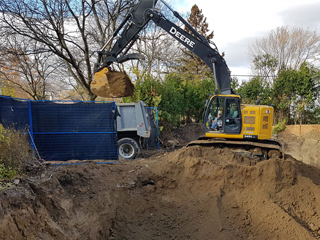So, you have gotten past the preparatory steps, and you are now ready to actually begin excavating your site. However, the excavation process is not as simple as it might seem; to the surprise of many, it is more than just the digging of a hole. There are a number of steps one must go through to complete a safe and successful excavation; however, many people remain unaware of these steps in particular and the complexity of excavation in general. Because of this, we here at ISA Co. Trading Inc., a premier Toronto-area excavation company, want to go through the steps you will have to go through as part of excavating.
First, you have to do rough-staking, which is essentially the outlining of the dimensions the property that you are (eventually) going to have built on the site. This step typically involves the placement of stakes and helps clearly outline what will actually be excavated; after all, any building needs a strong foundation, and an excavation is entirely necessary to build a foundation in the first place.
Next, you need to clear your site of any items that could serve as obstacles for the actual excavation. In fact, the previous step can aid in clearing, as the rough-staking can show clearly delineate the objects that need to be cleared.
The actual excavation is the next step. Compared to the others, what you do in this phase is fairly self-explanatory: acquire the appropriate equipment—bulldozers and dump trucks, etc.—and excavate the specified area. That’s all there is!
However, the excavation process does not end with the excavation of the site. Instead, you have to do some rough-grading, which is where you can use some of the excavated dirt to fill in some spaces on your site to set up the foundation of your future building and help with the draining of water. Depending on your vision of your prospective building, this step can also involve the placing of rich soil on top of this excavated dirt so as to allow grass to (eventually) grow.
Finally, you have arrived at the last step: erosion control. In this stage, you will have to follow local bylaws and guidelines to ensure that your property’s soil does not erode away upon contact with water. Thankfully, the growth of grass will stop this from becoming an issue, which is why the rough-grading stage of excavation can be so critical. After this stage, you have now completed the excavation process. Congratulations!
If you would like to learn more about excavation or the excavation services and equipment that we offer, check out our website at https://isacoexcavation.com

